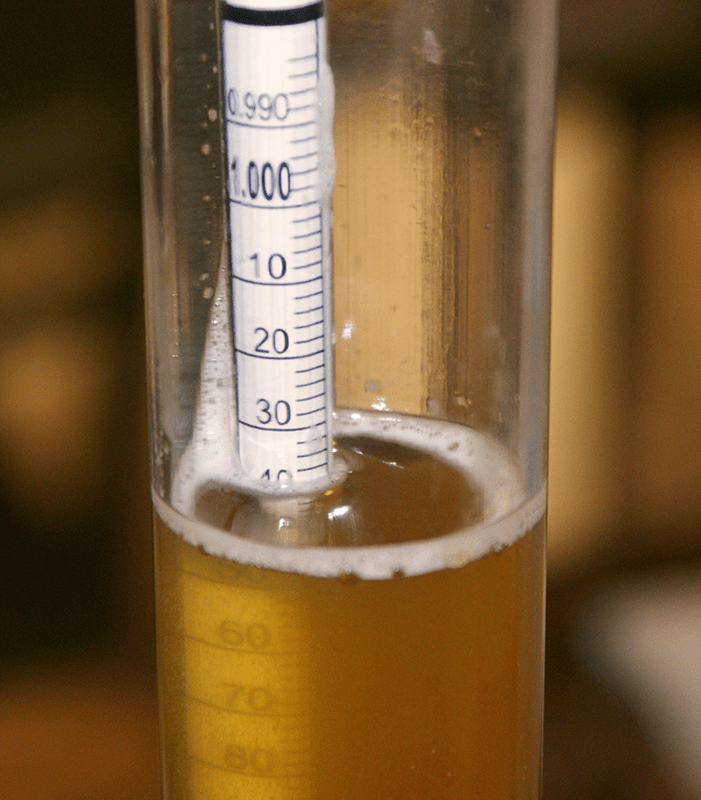 A wine hydrometer plays many different roles in home wine making. It can track a fermentation’s progress. It can tell you if your fermentation has completed and not just stuck… but one of its more interesting uses is controlling your wine’s alcohol level.
A wine hydrometer plays many different roles in home wine making. It can track a fermentation’s progress. It can tell you if your fermentation has completed and not just stuck… but one of its more interesting uses is controlling your wine’s alcohol level.
By using the wine hydrometer to help you adjust your beginning reading – before fermentation – you can control how much alcohol your wine will have when the fermentation has completed.
One of the scales you will find on a wine hydrometer is the potential alcohol scale. This hydrometer scale is only useful before the fermentation starts. What it is telling you is how much potential for alcohol your juice currently possesses.
As you add more sugar to the wine must the reading on the potential alcohol scale will rise. What this means is as the sugar rises you have a potential for more alcohol. The reason it is potential is because it hasn’t happened yet, and the alcohol is dependent on the fermentation fermenting all the sugars in the wine must.
 As an example, if you have a beginning reading on the potential alcohol scale of 11% this means that your wine will have 11% alcohol when the fermentation is finished – provided the fermentation was allow to run its full course. Basically, the wine making hydrometer is telling you how much alcohol that sugar can make.
As an example, if you have a beginning reading on the potential alcohol scale of 11% this means that your wine will have 11% alcohol when the fermentation is finished – provided the fermentation was allow to run its full course. Basically, the wine making hydrometer is telling you how much alcohol that sugar can make.
As another example, if your wine hydrometer had a starting reading of 13% potential alcohol and after the fermentation the reading was 1%, that means your wine currently has 12% alcohol.
If you want the fermentation to potentially make more alcohol, just add more sugar to the wine must until the potential alcohol scale on the hydrometer reads the alcohol level you want the wine to end up with.
As a final note, we do not recommend shooting for alcohol levels higher than 14%. If more sugar is added than the wine yeast can handle you may end up with an extremely sweet wine or, worse yet, a stuck fermentation.
So, while the wine hydrometer has many functions, one of its most useful is it allows the home winemaker to control the level of alcohol their finished wine will have. If you are still unsure, we have more information about using a wine making hydrometer and it’s functions in the wine making process on our website.
Happy Wine Making

Dear Ed,
Thank you for the very informative articles you write in your site. After reading your article about the use of the hydrometer to read level of sugar or potential alcohol content in a kit, can you add more sugar to a wine kit to increase the potential final content of alcohol?
Thanks,
Joaquin
Joquin, yes you can add more sugar to raise the potential alcohol of a wine must. However, there are limits as to how far you can go. Wine yeast can only ferment so-much alcohol before they will go dormant. Here is some more information on this subject:
Making High Alcohol Wines
http://www.eckraus.com/wine-making-high-alcohol
As Ed says, yes you can, but be sure that your yeast will handle the level you are shooting for. I have made hundreds of dry & semi-dry bottles above 18%. For better flavor without HOT taste, additional fruit and extended aging, I now shoot for 15 – 16%.
I recently had the pleasure of drinking a 2012 Muscat produced by a well known Napa winery. It was very thick, sweet, fruity and delicious, but was only 7.5% alcohol. It was not a sparkling wine. I inquired about how they made such a wine, but have not received an answer. Given your instructions that all wines must go full fermentation prior to adding sugar/sweetness, how could they make such a low alcohol wine without diluting withheld grape juice into the wine at bottling along with potassium metabisulfite?. Did they use a cold fermentation process or use a lot of potassium sorbate to arrest fermentation? I always respect your take on questions, so your opinion is appreciated.
Sweet wine is achieved by either sweetening after fermentation has completed OR stopping fermentation early before all sugars have converted to alcohol. Don’t know but maybe there is yeast that will die off under 8%?